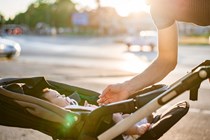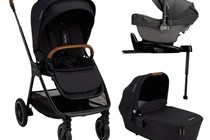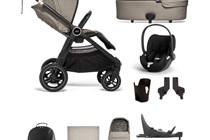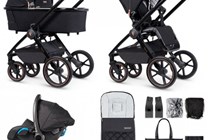If you’re expecting a bundle of joy, investing in the best travel system as a new parent is a smart way to go. A travel system is essentially a pushchair and car seat combined, designed to make it as easy as possible to take baby on the go – you can move them into the car without having to remove them from their car seat. You simply detach the car seat when it’s time to get in the car and fold the pushchair frame down to pop in the boot. Anything that makes parenting easier is a yes in our books.
The cost of baby essentials adds up pretty quickly, but a travel system is a bundle purchase that covers some pricey essentials for the first year of a baby’s life. Travel systems fit Group 0+ car seats only so can be used until your little one is around 12-15 months. You’ll often find 3in1 travel systems include a carrycot too so you can use the pushchair as a lie-flat pram – an important addition to support the development of baby’s spine and lungs until they’re six months old.
Prices for travel systems range from under £250 up to over £1,000 with added handy extras, such as changing bags and footmuffs. We’d recommend making a list of must-have features to ensure it fits your car and you’re getting good value for money. We’ve explored this in more detail in our FAQs section but for now, here’s our pick of the best travel systems for getting out and about with a little help from our friends at Mother&Baby.
Best travel systems at a glance
Best overall: Joie Baby Finiti Bundle – View on John Lewis
Best for simplicity: Venicci Tinum 3in1 Travel System Bundle – View on Kiddies Kingdom
Best on a budget: Kinderkraft Travel System 3in1 NEWLY – View on Kinderkraft
Best travel systems in more detail
Best overall
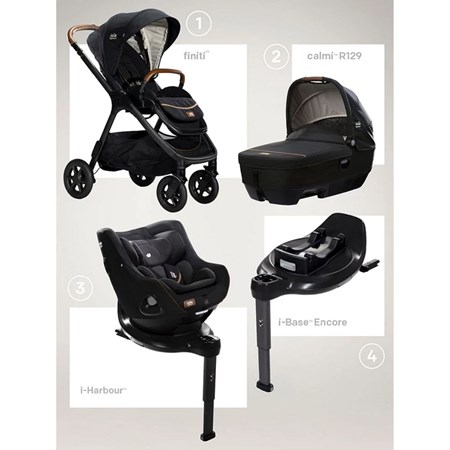

Read the review of the Joie Baby Finiti Bundle on our sister site, Mother&Baby.
Pros
- Lightweight to push
- Durable suspension
- One hand fold
Cons
- Canopy doesn't completely cover seat when fully reclined
| Suitable from: | Birth to 22kg (approx. 4 years) |
| Accessories included: | Raincover, adapters |
| Handle height: | 100-108cm |
| ISOFIX compatible: | Yes |
Best for simplicity


Read the review of the Venicci Tinum 3in1 Travel System Bundle on our sister site, Mother&Baby.
Pros
- One hand fold
- Stylish design
- Rotary front wheels 360°
Cons
- ISOFIX costs extra
| Suitable from: | Birth to 22kg |
| Accessories included: | Footmuff, rain cover, mosquito net, changing mat, luxury designer changing bag |
| Handle height: | 91-105cm |
| ISOFIX compatible: | No but available at extra cost |
Best on a budget
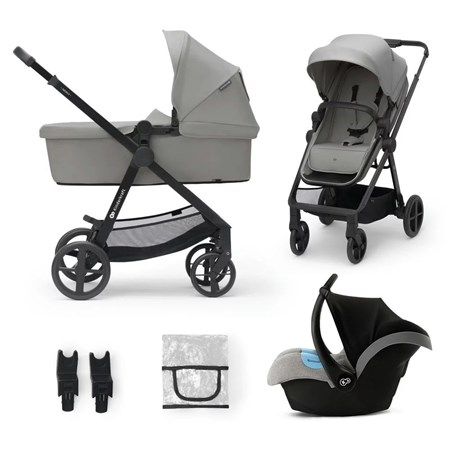

Pros
- Great value for money
- Lightweight
Cons
- New product so no customer reviews just yet
| Suitable from: | Birth to 22kg |
| Accessories included: | Leg moof, rain cover, universal adapters |
| Handle height: | 92-100cm |
| ISOFIX compatible: | N/A |
Best for style and substance


Read the review of the Mamas and Papas Ocarro on our sister site, Mother&Baby.
Pros
- Dual suspension for even terrain
- Easy to carry when folded
- One hand fold
Cons
- Basket can be difficult to access with larger item
| Suitable from: | Birth to 22kg |
| Accessories included: | Adaptors, Ocarro footmuff, changing bag, universal cup holder, Nocturn baby blanket |
| Handle height: | 101cm (adjustable) |
| ISOFIX compatible: | Yes |
Best for vibrant design
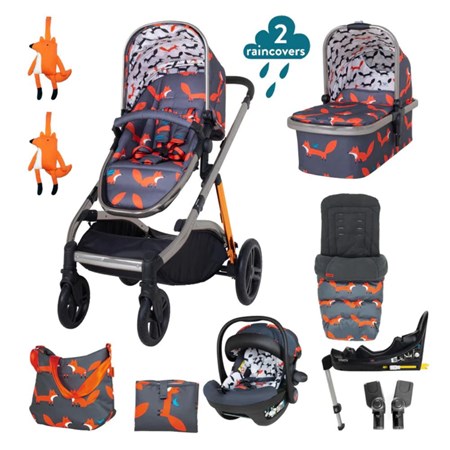

Customer review: "This pram is amazing as it has the built in buggy board. This is one reason I bought it as I needed a way for my toddler to get about as well as my baby. She has the option of another seat or the buggy board. It is a bit heavier to push than some pushchairs but it is easy to manoeuvre for a double. I absolutely love the fox design, I love the funky patterns used by Cosatto which is another reason I went for this brand!"
Pros
- Fun designs
- Has a built-in buggy board for toots
- Tiny boot approved (Fiat 500 checked)
Cons
- Little heavier compared to some pushchairs
| Suitable from: | Birth to 25kg |
| Accessories included: | Changing bag, changing mat, footmuff, two rain covers, adaptors |
| Handle height: | 104-110cm |
| ISOFIX compatible: | Yes |
Best for city living


Read the review of the Nuna TRIV Next on our sister site, Mother&Baby.
Pros
- Very compact when folded
- Lightweight
- Easy to steer
Cons
- Poor suspension
| Suitable from: | Birth to 22kg |
| Accessories include: | N/A |
| Handle height: | 106-110cm |
| ISOFIX compatible: | Yes |
Best for all-terrains
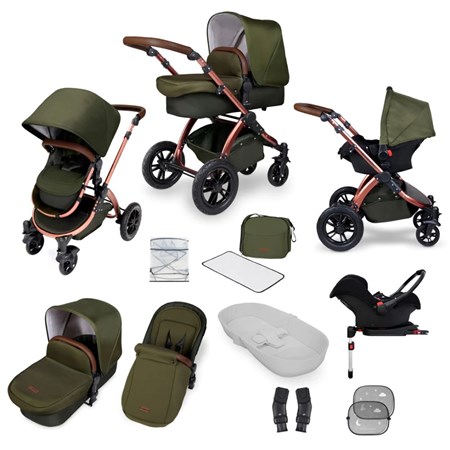

Read the review of the Ickle Bubba Stomp V4 on our sister site, Mother&Baby.
Pros
- Sturdy
- Easy to connect to the car
- Quite compact once folded
Cons
- Some found it a little tricky to fold down
| Suitable from: | Birth to 22kg |
| Accessories included: | Carrycot apron, hood and safety mattress, footwarmer, changing mat, changing bag, footmuff, rain cover, two sun visors |
| Handle height: | 65-104cm |
| ISOFIX compatible: | Yes |
Best for ample pushchair storage
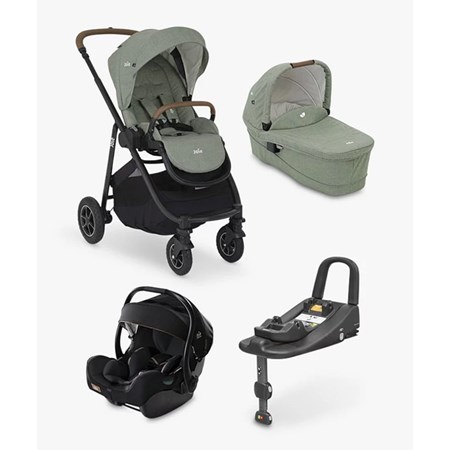

Read the review of the Joie Baby Versatrax on our sister site, Mother&Baby.
Pros
- Large basket
- Excellent foldability
- Sturdy build
Cons
- Not as easy to adjust compared to other prams
| Suitable from: | Birth to 22kg |
| Accessories included: | N/A |
| Handle height: | 110-114cm |
| ISOFIX compatible: | Yes |
As mentioned, it’s important you’re getting the right features to suit your vehicle and lifestyle. Due to the convenience of a travel system, and what you get included, they are more expensive and sometimes bulkier than standard pushchairs and car seats. Therefore, you want to make sure all your boxes are ticked.
What to look for in the best travel system:
-
What should I look out for in a car seat?
As it's part of the travel system, the car seat included is a little more limited compared to some on the market. These are the key elements to consider:
Size: Travel systems are available in car seats of two sizes; Group 0 and Group 0+. Group 0 can be used from birth to 10kg (approx. 11 months), whilst Group 0+ goes until 13kg (approx. 15 months). It's worth keeping in mind that if you opt for a travel system, extended rear-facing won't be available to you. If this is important or would be best suited to your vehicle, you may want to stick with the traditional car seat route.
Weight: Car seats can be pretty hefty, so it's worth keeping in mind the weight of the car seat. You'll be carrying the car seat about more than a traditional car seat - switching it in and out of the car - and that's usually with a baby in tow too.
Fitting to your car: The car seat is more often than not included in the price, but be wary in case there are hidden costs. You may find yourself needing to buy a base or car-seat adaptor to fix it to the chassis of your car. These days, most car seats are secured into the car using an ISOFIX system which not only takes all the hassle out of getting your car seat in and out of the car, but it's the safest option to keep your baby secure. However, it's worth keeping in mind that not all travel systems will have this included. -
What are some things to watch out for in a pushchair?
Whilst the car seat can be used until your baby is about 15 months, the pushchair can be used beyond that. Most come with a regular pushchair seat included which can be fitted into the frame once baby outgrows their car seat. As with a regular pushchair, there are certain things to look for:
Shopping basket: A big basket is a big yes in our books. After all, it needs to carry all your baby essentials on the move, and then some. The basket should be accessible at all times, even if the seat is fully reclined or there's a carry cot or car seat in place.
Seat recline: Speaking of, a pushchair seat that reclines flat is a must for naps in a pushchair. It should be easy and quiet to adjust with baby in the seat.
Handles: Comfort is key. A height-adjustable handlebar is ideal for ensuring the pushchair is comfortable for you, your partner or anyone else who might use it regularly.
Seat direction: Some travel system pushchairs come with a reversible seat unit which means you can choose which way your baby faces. A parent-facing seat encourages your baby's communication skills, but an inquisitive toddler might prefer to face where they're going.
Accessories: Some fun extras can be included, such as changing bags and footmuffs. Think about what you actually need as you may find these to be of no use if you've already got some at home.
Brake: The brake should be comfortably positioned and easy to operate without the risk of applying it by accident or scuffing your shoes. Check how reliable it feels and whether it's easy to release.
Wheels: Depending on where you're strolling with baby, you'll want wheels to suit the terrain. You can find smaller, sold wheels that are ideal for pavement stomping and shop floors, or all-terrain wheels for easy manoeuvrability on more uneven ground. If you're likely to go everywhere and anywhere, consider choosing lockable, swivel wheels instead.
Fold mechanism: All travel systems fold up so that they can be stowed in a car boot, however, you may find some easier to operate than others, especially if you're trying to juggle baby. Pick one you'll find to be easy to fold.
Weight and size: Fortunately travel systems are more compact than ever, but some can still be on the bulky side. As you'll no doubt be folding the pushchair into your boot, make sure it can fit. You'll also be lifting it out the boot so consider its weight - anything over 10kg could be a struggle. -
Should I get a 2in1 or 3in1 travel system? What's the difference?
While a 2in1 travel system includes the car seat and pushchair, a 3in1 travel system has the added element of a carrycot. This can be switched out with their car seat on the pushchair frame, converted into a pushchair seat, and removed. This is a handy addition for when you're out and about or don't want to disturb your baby as they snooze. It comes with a heftier price tag, but seeing as the carrycot can double as a Moses basket or portable travel cot, it may prove invaluable for your home.
It's also worth noting that newborns should only remain in car seats for two hours at a time within a 24-hour time period. If you intend to keep them in their pram for long periods, opt for a 3-in-1 travel system or a fully reclining seat - making sure your baby lies flat is better for their breathing and spinal alignment. -
What options do I have for purchasing a travel system?
In terms of purchasing a travel system, you have two options. You can opt for a complete package from a single manufacturer - a simple and easy way of ensuring all the parts are compatible with each other.
Alternatively, you could buy separate components from different brands. This option is typically more expensive and requires extra planning to ensure all the parts are compatible - you may need to buy additional adaptors to fit the system together or find the car seat you've got your eye on isn't travel system compatible. However, once all is said and done, you get the benefit of a travel system you've built from scratch to make it perfect for you and your baby.
Eleanor Weaver is the Deputy Homes & Garden Product Editor for Modern Gardens, Yours, and Take A Break Pets, writing for Parkers.
Sign up to the Parkers Newsletter to keep up to date with more of the latest reviews, news, and recommendations from the Parkers team.
Just so you know, whilst we may receive a commission or other compensation from the links on this website, we never allow this to influence product selections – read why you should trust us
Just so you know, we may receive a commission or other compensation from the links on this website - read why you should trust us.



